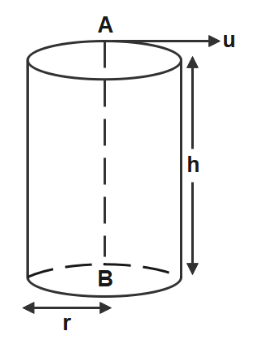
A hollow vertical cylinder of radius
A.
B.
C.
D.


Answer
405k+ views
Hint:In order to solve the question, we will first take the vertical motion into account using the second law of motion we will find the time and then we will take the horizontal motion into for which we substitute the value of time into the relation between time, horizontal distance and the horizontal velocity
Formula used:
Where,
Complete step by step answer:
In the question we are given a hollow vertical cylinder which has a smooth internal surface. A small particle is placed in contact with the inner side of the upper rim, at point A, and given a horizontal speed, tangential to the rim. It leaves the lower rim at point B, vertically below A.
Radius of hollow vertical cylinder =
Height of hollow vertical cylinder of hollow vertical cylinder =
Horizontal speed =
In the vertical direction the velocity is zero. Using the second equation of motion we will find the height of the cylinder which the particle travels.
Second equation of motion
S is the height “h”
a is the acceleration which in this case g
vertical velocity = 0
substituting the values of a, g, u
Hence height is
Now we will find the value of t
Taking 2 and g on the other side
Now we will see the motion in the horizontal direction.
Horizontal speed =
Radius is
Where d =
We get
Now substituting the value of
Solving for n and we get
Hence, the correct option is A.
Note:Many of the students will make the mistake by not taking the horizontal and the vertical motion separately as well as the only the time is the physical quantity which is constant either it is vertical motion or it is horizontal motion so which makes substituting the value of time will be the easiest way to find the other physical quantities.
Formula used:
Where,
Complete step by step answer:
In the question we are given a hollow vertical cylinder which has a smooth internal surface. A small particle is placed in contact with the inner side of the upper rim, at point A, and given a horizontal speed, tangential to the rim. It leaves the lower rim at point B, vertically below A.
Radius of hollow vertical cylinder =
Height of hollow vertical cylinder of hollow vertical cylinder =
Horizontal speed =
In the vertical direction the velocity is zero. Using the second equation of motion we will find the height of the cylinder which the particle travels.
Second equation of motion
S is the height “h”
a is the acceleration which in this case g
vertical velocity = 0
substituting the values of a, g, u
Hence height is
Now we will find the value of t
Taking 2 and g on the other side
Now we will see the motion in the horizontal direction.
Horizontal speed =
Radius is
Where d =
We get
Now substituting the value of
Solving for n and we get
Hence, the correct option is A.
Note:Many of the students will make the mistake by not taking the horizontal and the vertical motion separately as well as the only the time is the physical quantity which is constant either it is vertical motion or it is horizontal motion so which makes substituting the value of time will be the easiest way to find the other physical quantities.
Latest Vedantu courses for you
Grade 11 Science PCM | CBSE | SCHOOL | English
CBSE (2025-26)
School Full course for CBSE students
₹41,848 per year
Recently Updated Pages
What types of resources are rocks and metals A Abiotic class 7 social science CBSE

Find the perimeter of a regular hexagon with each side class 7 maths CBSE

The cube root of a negative integer is a Negative b class 7 maths CBSE

The process of finding the factors of a given number class 7 maths CBSE

State for what purpose bleaching powder is used in class 7 chemistry CBSE

The saclike structure between the small intestine and class 7 biology CBSE

Trending doubts
State and prove Bernoullis theorem class 11 physics CBSE

What are Quantum numbers Explain the quantum number class 11 chemistry CBSE

Write the differences between monocot plants and dicot class 11 biology CBSE

Who built the Grand Trunk Road AChandragupta Maurya class 11 social science CBSE

1 ton equals to A 100 kg B 1000 kg C 10 kg D 10000 class 11 physics CBSE

State the laws of reflection of light




